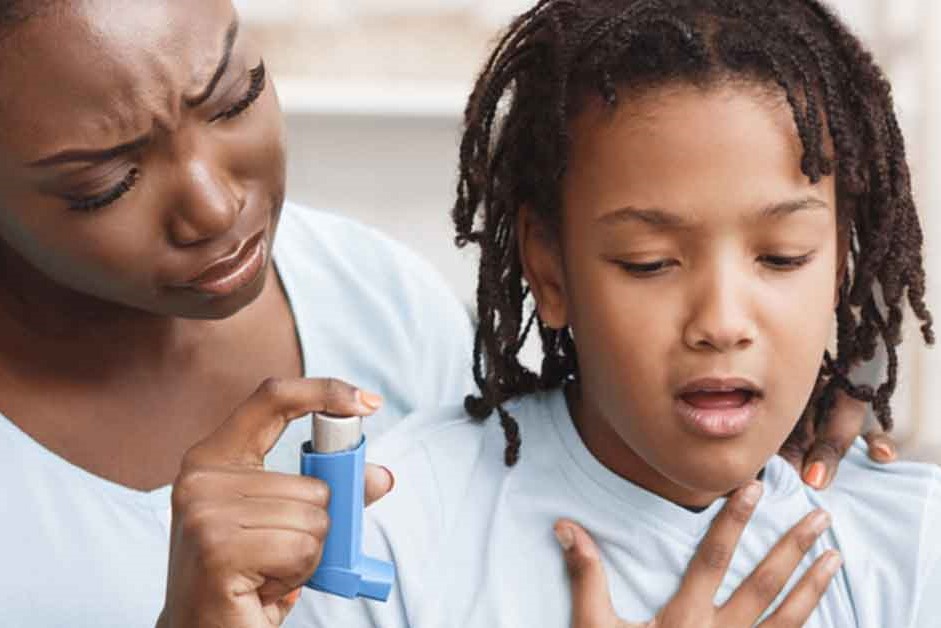
Symptoms of asthma attack and first aid to sufferers
Asthma is a respiratory condition that affects your lungs. It causes repeated episodes of wheezing, breathlessness, chest tightness, and nighttime or early morning coughing
Asthma can be controlled by taking medicine and avoiding the triggers
However, when symptoms get worse, it is called an asthma attack. Asthma affects people of all ages and often starts during childhood.
Asthma is more common in adult women than adult men.
Asthma is the leading chronic disease in children.
What happens When an Asthma Attack Goes Untreated?
An asthma attack is a sudden worsening of asthma symptoms caused by the tightening of muscles around your airways (bronchospasm).
During the asthma attack, the lining of the airways also becomes swollen or inflamed, and thicker mucus, more than usual – is produced.
Various symptoms of an asthma attack may include:
Severe wheezing when breathing both in and out
- Coughing that won’t stop
- Very rapid breathing
- Chest tightness or pressure
- Tightened neck and chest muscles, called retractions
- Difficulty talking
- Feelings of anxiety or panic
- Pale, sweaty face
- Blue lips or fingernails
- Or worsening symptoms despite use of your medications
The duration of an asthma attack can vary
It mostly depends on what caused it and how long the airways were inflamed.
Mild episodes may last only a few minutes; more severe ones can last from hours to days.
Mild attacks can resolve spontaneously or may require medication, typically a quick-acting inhaler.
But in acute asthma attacks, if you do not receive adequate treatment, you may eventually be unable to speak and can develop a bluish coloring around your lips.
This color change, known as ‘cyanosis,’ means you have less and less oxygen in your blood.
Without immediate aggressive treatment in an emergency room or intensive care unit, you may lose consciousness – it can even be life-threatening. (WebMD)
Everyone who lives with allergic asthma can help protect their health by learning the basics of asthma first-aid.
Asthma Action Plan
A good preventive step is to create an asthma action plan with your doctor.
An asthma action plan can help you be prepared if your symptoms flare-up.
If you’re having an allergic asthma attack, address your symptoms right away.
If your symptoms are mild, take your quick-relief medication.
You should feel better after 20 to 60 minutes.
If you get worse or do not improve, then you should seek medical attention immediately.
Call for emergency medical help and take these steps while you wait for help to arrive.
Action Steps:
Take medication and move away from triggers – As soon as you notice symptoms of an asthma attack, such as wheezing or chest tightness, take your rescue inhaler.
Pay attention to whether you exposed yourself to allergens that triggered your asthma, such as pets or cigarette smoke.
Move away from any source of allergens.
Ask someone to stay with you – It’s risky to be alone if you’re having an asthma attack.
Let someone in your immediate area know what’s happening.
Ask your attendant to stay with you until your symptoms improve or emergency help arrives.
Sit upright and try to remain calm– During an asthma attack, it’s best to be in an upright posture.
Don’t lie down. It also helps to try to stay calm, since panic may worsen your symptoms.
Try to take slow, steady breaths.
Continue using rescue medication as instructed – If your symptoms are severe, use your rescue medication while you wait for help.
Follow the instructions that your doctor or pharmacist-provided for using your rescue medication in an emergency.
Don’t hesitate to call for emergency help if you’re experiencing asthma symptoms.
An asthma attack can worsen quickly, especially in children. (Healthline)
Asthma Can Be Managed
Sticking to your treatment plan can help prevent your asthma symptoms from worsening.
If you are taking multiple treatments but still experiencing symptoms, you might need more help managing your condition.
Your doctor may recommend a combination of prescription medications, complementary therapies, and lifestyle changes.
These options can help you manage the condition more effectively.
References
“Asthma.” Centers for Disease Control and Prevention, Centers for Disease Control and Prevention, 14 Apr. 2020, www.cdc.gov/asthma/default.htm.
“AAFA.” Asthma Facts | AAFA.org, www.aafa.org/asthma-facts/.Asthma attack
https://www.webmd.com/asthma/asthma-attack
“Asthma Attack.” ACAAI Public Website, 8 Jan. 2019, acaai.org/asthma/symptoms/asthma-attack.
Donnelly, Christina. “Allergic Asthma Attack: When Do You Need to Go to the Hospital?” Healthline, 13 Mar. 2019, Allergic Asthma Attack: When Do You Need to Go to the Hospital?
“Asthma.” National Heart Lung and Blood Institute, U.S. Department of Health and Human Services, www.nhlbi.nih.gov/health-topics/asthma.
Asthma action plan
https://www.lung.org/getmedia/1bb7284c-4b2b-45da-b54d-c24012207957/asthma-action-plan.pdf
Read Also
Emergency Live Even More…Live: Download The New Free App Of Your Newspaper For IOS And Android
Bronchial Asthma: Symptoms And Treatment
Bronchitis: Symptoms And Treatment
Bronchiolitis: Symptoms, Diagnosis, Treatment
Extrinsic, Intrinsic, Occupational, Stable Bronchial Asthma: Causes, Symptoms, Treatment
Chest Pain In Children: How To Assess It, What Causes It
Bronchoscopy: Ambu Set New Standards For Single-Use Endoscope
What Is Chronic Obstructive Pulmonary Disease (COPD)?
Respiratory Syncytial Virus (RSV): How We Protect Our Children
Respiratory Syncytial Virus (RSV), 5 Tips For Parents
Infants’ Syncytial Virus, Italian Paediatricians: ‘Gone With Covid, But It Will Come Back’
Respiratory Syncytial Virus: A Potential Role For Ibuprofen In Older Adults’ Immunity To RSV
Neonatal Respiratory Distress: Factors To Take Into Account
Stress And Distress During Pregnancy: How To Protect Both Mother And Child
Respiratory Distress: What Are The Signs Of Respiratory Distress In Newborns?
Respiratory Distress Syndrome (ARDS): Therapy, Mechanical Ventilation, Monitoring
Bronchiolitis: Symptoms, Diagnosis, Treatment
Chest Pain In Children: How To Assess It, What Causes It
Bronchoscopy: Ambu Set New Standards For Single-Use Endoscope
Bronchiolitis In Paediatric Age: The Respiratory Syncytial Virus (VRS)
Pulmonary Emphysema: Causes, Symptoms, Diagnosis, Tests, Treatment
Bronchiolitis In Infants: Symptoms


